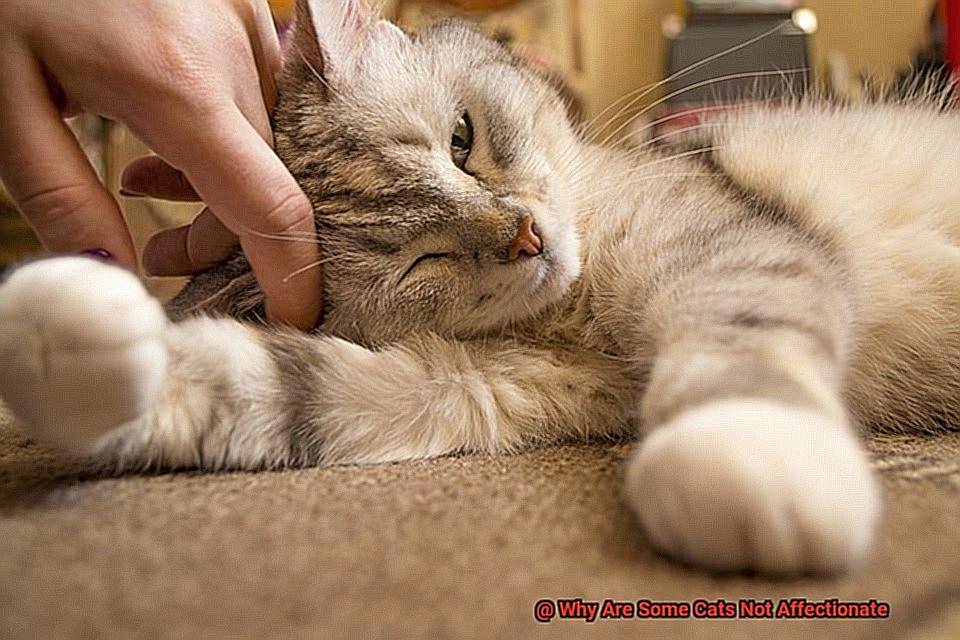Cats are notorious for their independent streaks, often preferring to do their own thing rather than snuggle up with their human companions. But what about those cats who seem downright uninterested in any form of affection? If you’ve ever found yourself wondering why your feline friend seems to be avoiding your attempts at cuddling, then this blog post is for you.
In this post, we’ll delve into the possible reasons behind a cat’s lack of affection, from their breeding and environment to their individual personality traits. We’ll also explore ways to encourage more loving behavior from our furry friends while still respecting their need for personal space.
So whether you’re a seasoned cat owner or simply curious about these enigmatic creatures, read on to discover why some cats may not be as cuddly as we’d like them to be and how we can work towards building stronger bonds with them.
Personality: Some Cats Have an Independent Nature
Cats are fascinating creatures with an independent spirit that sets them apart from other pets. As an expert in this field, I can tell you that while some cats are naturally more aloof than others, there are several reasons why they may seem uninterested in affection or interaction with their owners.
Firstly, the evolutionary history of cats contributes to their independent nature. Unlike dogs, cats were not domesticated for specific tasks and did not rely on humans for survival. Instead, they were attracted to human settlements because of the availability of food and shelter. This means that cats have always been able to survive on their own, without relying on humans for their well-being.
Furthermore, cats are highly territorial animals who need their own space to feel secure. They may become stressed or anxious if they feel that their territory is being invaded or if they are forced to share their space with other animals or humans. This territorial behavior also means that cats have a unique personality that determines how much physical contact and interaction they desire.
Past experiences can also impact a cat’s willingness to show affection, as negative interactions with humans can lead to fear and defensiveness around people. This may cause them to avoid physical contact and interaction altogether. However, it’s important to note that just because a cat is not affectionate doesn’t mean that they don’t love their owner. Cats have different ways of showing affection, such as rubbing against their owner’s legs or bringing them gifts such as dead mice or birds.
It’s crucial for owners to create a positive environment that encourages positive interactions with their feline friends. Providing enough mental and physical stimulation through toys and playtime can help prevent boredom and anxiety, which can affect a cat’s desire for affection. Owners can also try spending more time with their cat and providing positive reinforcement when the cat displays affectionate behavior.
Past Experiences: Negative Interactions with Humans
Cats who have been mistreated, neglected, or abused may exhibit fearful or defensive behavior towards humans. This can lead to a lack of trust and reluctance to engage in affectionate behaviors.
Physical abuse can cause cats to associate touch with pain and fear, resulting in avoidance or aggression when touched. Neglect can lead to a lack of positive interactions with humans and a misunderstanding of how to engage in affectionate behaviors.
It’s crucial to note that not all cats who are not affectionate have experienced negative interactions with humans. Some cats may simply be less social or independent. However, if you suspect your cat’s behavior is due to past trauma, approach them with patience and understanding.
To help your cat overcome their fear or mistrust of humans, create a safe and comfortable environment for them. Offer hiding spots, cozy beds, and toys to keep them occupied. Avoid forcing physical contact or overwhelming them with attention as this can reinforce their fear.
Working with a professional animal behaviorist can also be beneficial in addressing past trauma and helping your cat learn to trust humans again.
Environment: A Need for a Safe and Comfortable Space
Let’s explore the factors that contribute to creating a conducive living space for our furry companions.
Living Space Matters
Providing your cat with enough space to move around and play is crucial. Cats require a place where they feel secure and comfortable. A lack of space or overcrowding can cause stress and anxiety in cats, leading them to become distant and less affectionate towards their owners. It’s vital to ensure that they have plenty of room to stretch, climb, and explore.
Type of Living Space
The type of living space can also play a role in a cat’s affection levels. For instance, if your cat lives in an apartment with no access to the outdoors, they may become bored and frustrated. This can limit their natural instincts to hunt and explore, leading them to be less affectionate towards their owners. Providing access to the outdoors or creating an indoor environment that mimics the outdoors can help satisfy their innate desires.

Presence of Other Pets or Humans
Cats are sensitive creatures and may feel threatened or uncomfortable around other animals or humans in the household. If this happens, they may retreat and become less affectionate towards their owners. Creating an environment where your cat feels safe and secure is essential, limiting exposure to stress-inducing factors such as overcrowding or conflicts with other pets or humans.
Lack of Stimulation: Mental and Physical Stimulation
However, a lack of stimulation, both mental and physical, could be the underlying cause of your cat’s withdrawn behavior. Cats are natural predators who require stimulation to maintain their well-being and stay content. Without it, they can become bored, anxious or even depressed.
Mental stimulation is essential for cats, and interactive toys and games that challenge their hunting instincts can do wonders for their mental health. Puzzle feeders are also an excellent way to keep their brains engaged while they eat. These activities not only prevent boredom but also help keep your cat’s mind sharp and active.
Physical stimulation is equally crucial for cats as they need exercise to stay healthy and maintain their muscle tone. A lack of physical activity can lead to obesity, which can further aggravate any existing health issues. You can encourage your cat to play with toys that promote movement like feather wands or laser pointers, or provide them with a scratching post or climbing tree to keep them active.
It’s important to note that every cat has unique needs when it comes to stimulation. Some may require more mental or physical activity than others. Therefore, it’s crucial to observe your cat’s behavior and adjust accordingly.
Signs of Affection: How to Recognize Affectionate Behavior in Cats
As a cat owner, it’s important to understand the signs of affection that cats display to show their love towards their owners.
Firstly, purring is a well-known sign of a happy cat. It’s a rumbling sound that they make when they are content and relaxed. So, if your cat is curled up on your lap and purring away, take it as a compliment that they feel comfortable and content in your presence.
Secondly, head-butting may seem odd to some, but it’s actually a sign of affection in cats. When cats rub their heads against their owners, they are marking them with their scent as a way of showing ownership and claiming you as part of their social group. This behavior is often seen in cats who are happy and comfortable around their owner.
Thirdly, kneading is when cats push their paws in and out on soft surfaces, such as blankets or pillows. This behavior is often seen in kittens when nursing from their mother, as it helps stimulate milk production. If your cat kneads on you or nearby objects, it’s a sign that they feel safe and comfortable around you. It’s also a sign of affection because they associate the action with comfort.
Fourthly, licking is another sign of affection in cats. Cats groom themselves and each other as a way of bonding within their social group. If your cat licks you, they are showing you the same level of trust and affection that they would show another cat in their group. It’s also a way for them to show that they accept you as part of their family.
Lastly, if your cat follows you around the house or wants to be near you frequently, take it as a compliment. Cats are independent creatures by nature, so if they choose to spend time with you instead of alone, it’s a sign that they enjoy being in your company. It’s also a sign that they feel safe and protected around you.
It’s important to note that not all cats will display affection in the same way. Some may be more reserved or prefer to show their love through actions such as bringing you gifts like mice or toys. However, if your cat displays any of these behaviors towards you, it’s a good indication that they feel safe, comfortable, and content in your presence.
Understanding Your Cat’s Needs: Tailoring the Environment to Your Cat’s Preferences
Understanding Your Cat’s Needs: Tailoring the Environment to Your Cat’s Preferences
Have you ever wondered why your cat may not be as affectionate as you’d like them to be? It could be due to their environment. Cats are creatures of habit and have specific preferences when it comes to their surroundings. If their environment does not meet their unique needs, they may become stressed or anxious, leading to a lack of affection towards their owners.
So, what are some key environmental factors to consider when it comes to creating a comfortable and stimulating space for your feline friend? Let’s explore:
Food and Water Access:
First and foremost, make sure your cat always has access to clean water and fresh food. Additionally, consider the placement of their bowls. Cats prefer quiet areas away from foot traffic, so placing their bowls in a private area of the house that is not too noisy or busy is ideal.
Litter Box Placement and Cleanliness:
Cats are clean animals and prefer a clean litter box. Make sure to clean their litter box regularly and place it in a private area of the house that is not too noisy or busy. If the litter box is consistently dirty or in an area that is too noisy or busy, the cat may become stressed and avoid that area altogether.
Toy Availability:
Cats love to play and scratch, so be sure to provide them with plenty of toys and scratching posts. This not only helps them avoid destructive behavior but also provides them with mental stimulation and exercise.
Vertical Space:
Cats thrive in environments with plenty of hiding spots and vertical spaces to climb. Consider adding shelves or cat trees to your home to give your feline friend ample opportunities for climbing and exploring. This not only provides them with exercise but also helps them feel safe and secure in their environment.
Individual Preferences:
It’s important to understand that each cat is unique in their preferences and needs. Some cats may prefer a quiet environment with minimal foot traffic, while others may crave attention and stimulation from their owners. By taking the time to understand your cat’s individual needs and preferences, you can create a space that encourages positive behavior and affection.
Bonding with Your Cat: Activities That Encourage Positive Interactions
Each cat has unique personalities, so it’s essential to find activities that work best for your furry companion. Here are some tips and tricks to encourage positive interactions with your cat.
Firstly, interactive activities are a great way to bond with your cat. Playing with toys like laser pointers, feather wands or strings can give your feline friend the mental stimulation and exercise they need. Plus, it creates a positive association between you and your cat.
Grooming is another activity that can strengthen the bond between you and your furry companion. Brushing their fur or giving them a massage can help to relax your cat and build trust. It also helps prevent hairballs and keeps their coat healthy.
Creating a routine for your cat can also provide stability and help them feel secure and loved. Feeding them at the same time every day and providing them with a comfortable and safe space are great ways to show your love and care for them.
Lastly, communication is vital in building a strong bond with your cat. Speaking to your cat in a friendly and soothing tone can provide comfort and familiarity for your furry friend. Though cats may not understand the words we say, they can pick up on the tone of our voice and body language.
Conclusion
In conclusion, cats are intriguing creatures with distinct personalities that influence their level of affection towards their owners. While some cats may naturally be more distant than others, there are various reasons why they may seem uninterested in affection or interaction with humans. These causes range from their evolutionary background to past experiences and surroundings.
To create a comfortable and stimulating space for your cat, it’s essential to comprehend their needs and preferences. Owners can encourage positive interactions with their feline companions by providing enough mental and physical stimulation through toys and playtime, spending quality time with them, and offering positive reinforcement when the cat displays affectionate behavior.
Recognizing the signs of affection that cats display is also important to show love towards their owners, such as purring, head-butting, kneading, licking, and following them around the house.
Bonding with your cat necessitates patience, understanding, and finding activities that work best for your furry friend. Interactive activities like playing with toys or grooming can strengthen the bond between you and your cat. Creating a routine for your cat can also provide stability while making them feel secure and loved.
In summary, developing stronger bonds with our feline friends entails having a profound understanding of their needs while respecting their need for personal space.







